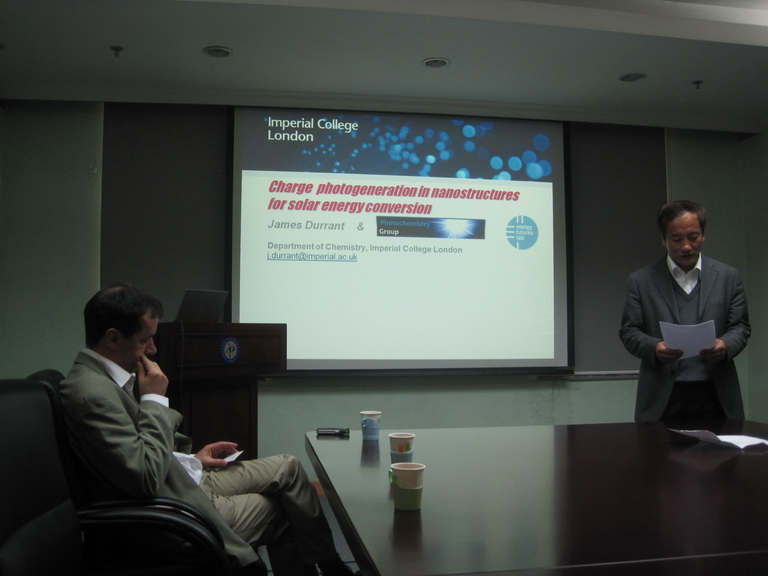光电化学系列讲座(三十三、三十四) 2011-4-16
中国可再生能源学会、光化学委员会光电化学系列讲座(三十三、三十四)

1. 报告题目:Charge Photogeneration in Nanostructures for Solar Energy Conversion
报告人:Prof. James Durrant
Department of Chemistry, Imperial College London, U.K
报告摘要
The reaction centres of photosynthetic organisms are undoubtedly the most sophisticated examples of photochemical energy conversion systems. My lecture will focus upon chemical systems designed to achieve analogous processes of charge separation and recombination for both solar to electricity and solar to molecular fuel energy conversion. I will start with an overview of the challenges associated with the use of nanostructured and molecular materials for solar energy conversion, presenting example of our studies of electron transfer kinetics in particular focusing upon dye sensitized solar cells as examples. I will then go on to focus upon the processes charge separation and recombination in photoelectrodes for solar water photolysis. I will focus upon dynamics in nanocrystalline TiO2- and Fe2O3 electrodes, but also consider dye sensitized and catalyst functionalised electrodes. My talk will discuss address in particular the role of recombination dynamics in limiting photoelectrode performance, and how these dynamics can be modulated both by electrical bias and surface functionalisation.
报告人简历
James Durrant is Professor of Photochemistry in the Department of Chemistry, Imperial College London, and Deputy Director of Imperial College’s Energy Futures Lab. Following undergraduate studies in Physics, his PhD and postdoctoral studies focused on the primary processes of plant photosynthesis. He joined the Chemistry Department in 1999, where he established an interdisciplinary research group focusing upon chemical approaches to solar energy conversion – harnessing solar energy either to produce electricity (photovoltaics) or molecular fuels (e.g.: hydrogen). His research is based around employing photochemical studies to elucidate design principles which enable technological development. His group is currently researching organic and dye sensitized nanostructured solar cells, as well as photoelectodes for solar fuel generation. He has published over 200 research papers and 5 patents, and has recently been awarded the 2009 Environment Prize by the Royal Society of Chemistry.
2. 报告题目:Solar Fuels: Nanomaterial Engineering and Fundamental Studies
报告人:Dr. Junwang Tang
Department of Chemical Engineering, University College London, U.K
报告摘要
Solar hydrogen production by means of photocatalytic water splitting over inorganic semiconductor is one of the most attractive approaches to achieve the renewable, clean energy. The key barrier is quite low efficiency in the technology after demonstration of feasibility of the approach by Fujishima et al. three decades ago. Nanocrystalline material is regarded as an efficient way to improve charge carriers separation, thus enhancing light conversion efficiency. Some nanocrystalline powder and nanostructured films synthesised in my group will be presented in the talk. In parallel increasing generation and utilization of the separated charge carriers is of particular interest apart from developing new materials absorbing more visible light because it is reported that ~90% of charge carriers is recombined within 10 ns in TiO2 colloids, which would make it very difficult to achieve high efficiency as the reactive steps would have to occur on a timescale faster than this for solar fuel generation. Measuring charge recombination processes and in particular reactions between reactants and charge carriers over candidate materials are therefore important steps in evaluating the materials and understanding mechanisms. We systematically studied the mechanism and the dynamics of photoholes and photoelectrons and kinetics between charge carriers and water will be emphasized in this talk.
报告人简历
Dr. Tang is currently a Lecturer in Chemical Engineering at University College London (UCL) and an Honorary Lecturer in Chemistry at Imperial College. Dr. Tang received his PhD in Physical Chemistry at Dalian Institute of Chemical Physics, CAS in 2001, and was awarded a highly competitive Outstanding President’s Prize of CAS. From 2002 to 2005, he was a researcher and Japan Society for the Promotion of Science (JSPS) Fellow in the National Institute for Materials Science (NIMS), Japan. In 2005, he moved to the Department of Chemistry, Imperial College, as a senior research associate to concentrate on fundamental research in photocatalysis, aiming to explore the key barriers limiting solar energy conversion efficiency. Since 2009, Dr. Tang joined the Department of Chemical Engineering, UCL as a Lecturer in Energy. Dr. Tang’s research interest is currently focusing on solar energy conversion to fuels including solar H2 production from water photolysis and CO2 photoconversion to methanol, drug delivery as well as organic contaminants photo-mineralisation. He has been recognized for his research on solar fuel with a Young Scientist Award by the International Association of Catalysis Societies at the quadrennial 14th International Congress on Catalysis, 2008. Totally more than 60 papers have been published, one of which has been cited 185 times over last few years and 8 patents filed (one has been awarded in English, German, Japanese and Chinese) besides many invited presentations and one chapter contribution to a popular CRC handbook.
